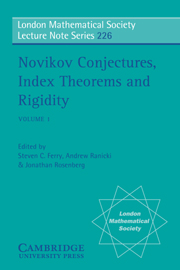On the Novikov conjecture
Published online by Cambridge University Press: 07 May 2010
Summary
Introduction
Signatures of quadratic forms play a central role in the classification theory of manifolds. The Hirzebruch theorem expresses the signature σ(N) ∈ ℤ of a 4k-dimensional manifold N4k in terms of the ℒ-genus ℒ(N) ∈ H4*(N;ℚ). The ‘higher signatures’ of a manifold M with fundamental group π1(M) = π are the signatures of the submanifolds N4k ⊂ M which are determined by the cohomology H*(Bπ;ℚ). The Novikov conjecture on the homotopy invariance of the higher signatures is of great importance in understanding the connection between the algebraic and geometric topology of high-dimensional manifolds. Progress in the field is measured by the class of groups π for which the conjecture has been verified. A wide variety of methods has been used to attack the conjecture, such as surgery theory, elliptic operators, C*-algebras, differential geometry, hyperbolic geometry, bounded/controlled topology, and algebra.
The diffeomorphism class of a closed differentiable m-dimensional manifold Mm is distinguished in its homotopy type up to a finite number of possibilities by the rational Pontrjagin classes p*(M) ∈ H4*(M;ℚ). Thom and Rokhlin-Shvartz proved that the rational Pontrjagin classes p*(M) are combinatorial invariants by showing that they determine and are determined by the signatures of closed 4k-dimensional submanifolds N4k ⊂ M × ℝj (j large) with trivial normal bundle. A homotopy equivalence of manifolds only preserves the global algebraic topology, and so need not preserve the local algebraic topology given by the Pontrjagin classes.
- Type
- Chapter
- Information
- Novikov Conjectures, Index Theorems, and RigidityOberwolfach 1993, pp. 272 - 337Publisher: Cambridge University PressPrint publication year: 1995
- 8
- Cited by



